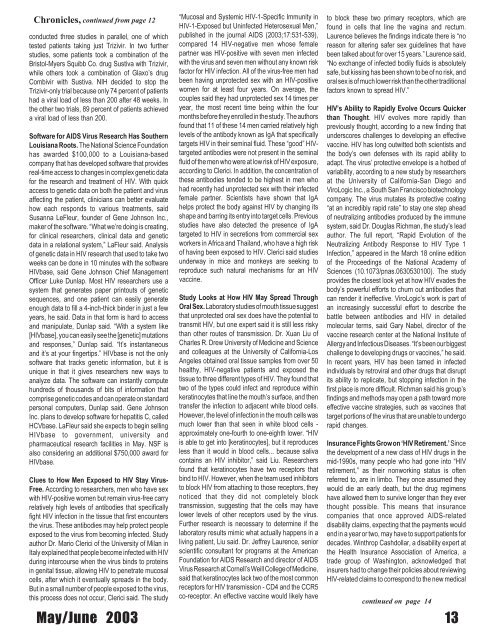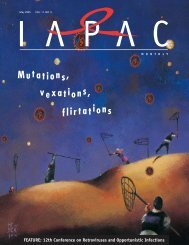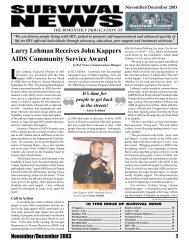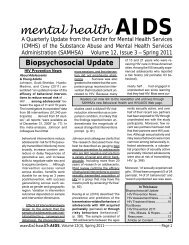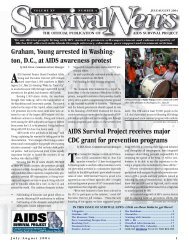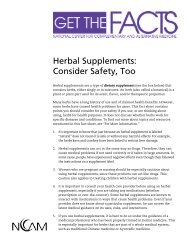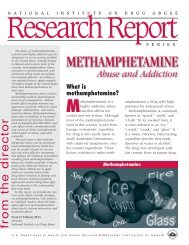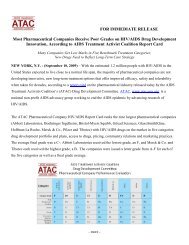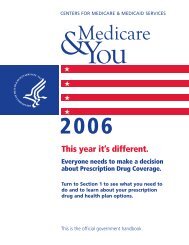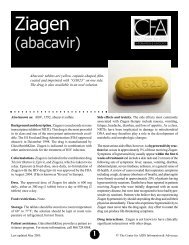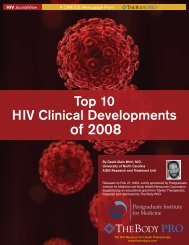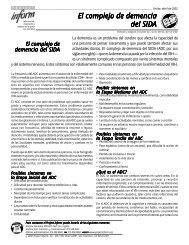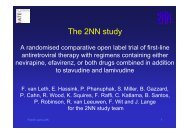Widespread Civil Disobedience Launches South African Campaign
Widespread Civil Disobedience Launches South African Campaign
Widespread Civil Disobedience Launches South African Campaign
Create successful ePaper yourself
Turn your PDF publications into a flip-book with our unique Google optimized e-Paper software.
Chronicles, continued from page 12<br />
conducted three studies in parallel, one of which<br />
tested patients taking just Trizivir. In two further<br />
studies, some patients took a combination of the<br />
Bristol-Myers Squibb Co. drug Sustiva with Trizivir,<br />
while others took a combination of Glaxo’s drug<br />
Combivir with Sustiva. NIH decided to stop the<br />
Trizivir-only trial because only 74 percent of patients<br />
had a viral load of less than 200 after 48 weeks. In<br />
the other two trials, 89 percent of patients achieved<br />
a viral load of less than 200.<br />
Software for AIDS Virus Research Has <strong>South</strong>ern<br />
Louisiana Roots. The National Science Foundation<br />
has awarded $100,000 to a Louisiana-based<br />
company that has developed software that provides<br />
real-time access to changes in complex genetic data<br />
for the research and treatment of HIV. With quick<br />
access to genetic data on both the patient and virus<br />
affecting the patient, clinicians can better evaluate<br />
how each responds to various treatments, said<br />
Susanna LeFleur, founder of Gene Johnson Inc.,<br />
maker of the software. “What we’re doing is creating,<br />
for clinical researchers, clinical data and genetic<br />
data in a relational system,” LaFleur said. Analysis<br />
of genetic data in HIV research that used to take two<br />
weeks can be done in 10 minutes with the software<br />
HIVbase, said Gene Johnson Chief Management<br />
Officer Luke Dunlap. Most HIV researchers use a<br />
system that generates paper printouts of genetic<br />
sequences, and one patient can easily generate<br />
enough data to fill a 4-inch-thick binder in just a few<br />
years, he said. Data in that form is hard to access<br />
and manipulate, Dunlap said. “With a system like<br />
[HIVbase], you can easily see the [genetic] mutations<br />
and responses,” Dunlap said. “It’s instantaneous<br />
and it’s at your fingertips.” HIVbase is not the only<br />
software that tracks genetic information, but it is<br />
unique in that it gives researchers new ways to<br />
analyze data. The software can instantly compute<br />
hundreds of thousands of bits of information that<br />
comprise genetic codes and can operate on standard<br />
personal computers, Dunlap said. Gene Johnson<br />
Inc. plans to develop software for hepatitis C, called<br />
HCVbase. LaFleur said she expects to begin selling<br />
HIVbase to government, university and<br />
pharmaceutical research facilities in May. NSF is<br />
also considering an additional $750,000 award for<br />
HIVbase.<br />
Clues to How Men Exposed to HIV Stay Virus-<br />
Free. According to researchers, men who have sex<br />
with HIV-positive women but remain virus-free carry<br />
relatively high levels of antibodies that specifically<br />
fight HIV infection in the tissue that first encounters<br />
the virus. These antibodies may help protect people<br />
exposed to the virus from becoming infected. Study<br />
author Dr. Mario Clerici of the University of Milan in<br />
Italy explained that people become infected with HIV<br />
during intercourse when the virus binds to proteins<br />
in genital tissue, allowing HIV to penetrate mucosal<br />
cells, after which it eventually spreads in the body.<br />
But in a small number of people exposed to the virus,<br />
this process does not occur, Clerici said. The study<br />
“Mucosal and Systemic HIV-1-Specific Immunity in<br />
HIV-1-Exposed but Uninfected Heterosexual Men,”<br />
published in the journal AIDS (2003;17:531-539),<br />
compared 14 HIV-negative men whose female<br />
partner was HIV-positive with seven men infected<br />
with the virus and seven men without any known risk<br />
factor for HIV infection. All of the virus-free men had<br />
been having unprotected sex with an HIV-positive<br />
women for at least four years. On average, the<br />
couples said they had unprotected sex 14 times per<br />
year, the most recent time being within the four<br />
months before they enrolled in the study. The authors<br />
found that 11 of these 14 men carried relatively high<br />
levels of the antibody known as IgA that specifically<br />
targets HIV in their seminal fluid. These “good” HIVtargeted<br />
antibodies were not present in the seminal<br />
fluid of the men who were at low risk of HIV exposure,<br />
according to Clerici. In addition, the concentration of<br />
these antibodies tended to be highest in men who<br />
had recently had unprotected sex with their infected<br />
female partner. Scientists have shown that IgA<br />
helps protect the body against HIV by changing its<br />
shape and barring its entry into target cells. Previous<br />
studies have also detected the presence of IgA<br />
targeted to HIV in secretions from commercial sex<br />
workers in Africa and Thailand, who have a high risk<br />
of having been exposed to HIV. Clerici said studies<br />
underway in mice and monkeys are seeking to<br />
reproduce such natural mechanisms for an HIV<br />
vaccine.<br />
Study Looks at How HIV May Spread Through<br />
Oral Sex. Laboratory studies of mouth tissue suggest<br />
that unprotected oral sex does have the potential to<br />
transmit HIV, but one expert said it is still less risky<br />
than other routes of transmission. Dr. Xuan Liu of<br />
Charles R. Drew University of Medicine and Science<br />
and colleagues at the University of California-Los<br />
Angeles obtained oral tissue samples from over 50<br />
healthy, HIV-negative patients and exposed the<br />
tissue to three different types of HIV. They found that<br />
two of the types could infect and reproduce within<br />
keratinocytes that line the mouth’s surface, and then<br />
transfer the infection to adjacent white blood cells.<br />
However, the level of infection in the mouth cells was<br />
much lower than that seen in white blood cells -<br />
approximately one-fourth to one-eighth lower. “HIV<br />
is able to get into [keratinocytes], but it reproduces<br />
less than it would in blood cells... because saliva<br />
contains an HIV inhibitor,” said Liu. Researchers<br />
found that keratinocytes have two receptors that<br />
bind to HIV. However, when the team used inhibitors<br />
to block HIV from attaching to those receptors, they<br />
noticed that they did not completely block<br />
transmission, suggesting that the cells may have<br />
lower levels of other receptors used by the virus.<br />
Further research is necessary to determine if the<br />
laboratory results mimic what actually happens in a<br />
living patient, Liu said. Dr. Jeffrey Laurence, senior<br />
scientific consultant for programs at the American<br />
Foundation for AIDS Research and director of AIDS<br />
Virus Research at Cornell’s Weill College of Medicine,<br />
said that keratinocytes lack two of the most common<br />
receptors for HIV transmission - CD4 and the CCR5<br />
co-receptor. An effective vaccine would likely have<br />
to block these two primary receptors, which are<br />
found in cells that line the vagina and rectum.<br />
Laurence believes the findings indicate there is “no<br />
reason for altering safer sex guidelines that have<br />
been talked about for over 15 years.” Laurence said,<br />
“No exchange of infected bodily fluids is absolutely<br />
safe, but kissing has been shown to be of no risk, and<br />
oral sex is of much lower risk than the other traditional<br />
factors known to spread HIV.”<br />
HIV’s Ability to Rapidly Evolve Occurs Quicker<br />
than Thought. HIV evolves more rapidly than<br />
previously thought, according to a new finding that<br />
underscores challenges to developing an effective<br />
vaccine. HIV has long outwitted both scientists and<br />
the body’s own defenses with its rapid ability to<br />
adapt. The virus’ protective envelope is a hotbed of<br />
variability, according to a new study by researchers<br />
at the University of California-San Diego and<br />
ViroLogic Inc., a <strong>South</strong> San Francisco biotechnology<br />
company. The virus mutates its protective coating<br />
“at an incredibly rapid rate” to stay one step ahead<br />
of neutralizing antibodies produced by the immune<br />
system, said Dr. Douglas Richman, the study’s lead<br />
author. The full report, “Rapid Evolution of the<br />
Neutralizing Antibody Response to HIV Type 1<br />
Infection,” appeared in the March 18 online edition<br />
of the Proceedings of the National Academy of<br />
Sciences (10.1073/pnas.0630530100). The study<br />
provides the closest look yet at how HIV evades the<br />
body’s powerful efforts to churn out antibodies that<br />
can render it ineffective. ViroLogic’s work is part of<br />
an increasingly successful effort to describe the<br />
battle between antibodies and HIV in detailed<br />
molecular terms, said Gary Nabel, director of the<br />
vaccine research center at the National Institute of<br />
Allergy and Infectious Diseases. “It’s been our biggest<br />
challenge to developing drugs or vaccines,” he said.<br />
In recent years, HIV has been tamed in infected<br />
individuals by retroviral and other drugs that disrupt<br />
its ability to replicate, but stopping infection in the<br />
first place is more difficult. Richman said his group’s<br />
findings and methods may open a path toward more<br />
effective vaccine strategies, such as vaccines that<br />
target portions of the virus that are unable to undergo<br />
rapid changes.<br />
Insurance Fights Grow on ‘HIV Retirement.’ Since<br />
the development of a new class of HIV drugs in the<br />
mid-1990s, many people who had gone into “HIV<br />
retirement,” as their nonworking status is often<br />
referred to, are in limbo. They once assumed they<br />
would die an early death, but the drug regimens<br />
have allowed them to survive longer than they ever<br />
thought possible. This means that insurance<br />
companies that once approved AIDS-related<br />
disability claims, expecting that the payments would<br />
end in a year or two, may have to support patients for<br />
decades. Winthrop Cashdollar, a disability expert at<br />
the Health Insurance Association of America, a<br />
trade group of Washington, acknowledged that<br />
insurers had to change their policies about reviewing<br />
HIV-related claims to correspond to the new medical<br />
continued on page 14<br />
May/June 2003 13


